Java Trees: Essential Habitats for Pet Birds
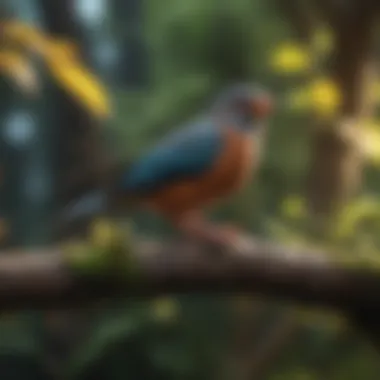
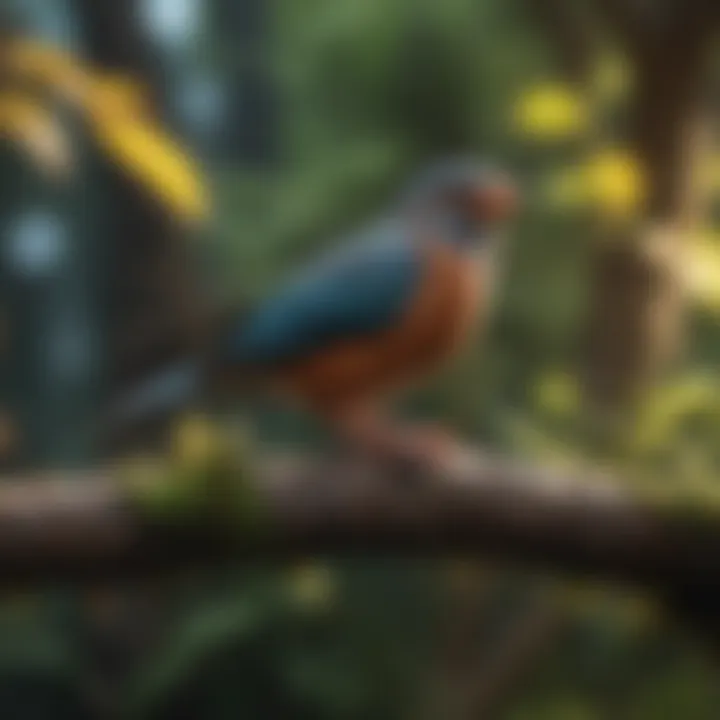
Intro
Exploring the relationship between Java trees and the world of birds opens up a fascinating discussion about ecology and avian habitats. These trees, with their robust and unique properties, have become relevant in pet bird care, not just for aesthetics but for their various ecological benefits. Bird owners and enthusiasts may not fully grasp the implications of integrating Java wood into their setups, but understanding its importance can significantly shift the dynamics of avian care. This deep dive will illuminate how Java trees provide suitable perches for pet birds while addressing care tips, behavioral insights, nutrition guides, wellness information, and enriching activities that promote healthy, happy birds.
Care Tips
Daily Care Routines
Establishing a routine for pet birds is like second nature to bird owners. Making sure they have fresh water and food daily is essential, but it doesn't stop there. Each morning could begin with a gentle hello, allowing the bird to acclimatize to the day before letting it out of the cage. Moreover, incorporating some hands-on time or just chit-chatting is crucial for building trust.
Cage Setup and Maintenance
The cage acts as a mini-habitat, reflecting a bird's natural surroundings. Java trees can play a pivotal role in this setup. Their branches can be arranged inside the cage for climbing and perching, creating a stimulating environment. It is important to ensure that perches vary in diameter to promote foot health. Swapping out any worn-out branches should be part of regular maintenance too—no one likes a rickety perch!
Hygiene and Cleaning Practices
Maintaining cleanliness is non-negotiable for any bird owner. Droppings and uneaten food should be cleared away daily to prevent health issues. Weekly scrub downs with bird-safe cleaners can remove built-up bacteria, ensuring a healthy space for your feathered friends.
Seasonal Care Adjustments
Seasons can impact bird care significantly. In winter, for instance, you may need to ensure that their environment is warm, while in summer, ventilation becomes your best friend. Java trees are excellent for humidity control, but ensuring that air circulates properly is equally crucial.
Behavioral Insights
Understanding your bird's behavior is like reading a novel, full of plots and twists. Here’s a brief insight:
Understanding Bird Body Language
Birds communicate more than we often realize. A puffed-up chest, flared feathers, or a head bob can be signs of excitement or contentment. Recognizing these signals plays a massive part in reassuring the pet.
Common Behavioral Issues and Solutions
Every bird has its quirks, but sometimes those quirks tiptoe into unwanted behavior, like excessive squawking or feather plucking. Observing patterns and identifying triggers are essential first steps. Solutions often lie in improving the bird's environment or routines, so don’t shy away from making adjustments.
Positive Reinforcement Techniques
Instead of reprimanding your feathered friend for missteps, consider using positive reinforcement, such as treats or affection. Birds thrive on reward-based interactions, making it a win-win.
Social Interaction Needs
Birds are social creatures. Spending quality time with them isn't just nice; it's necessary. Regular interaction enriches their lives and keeps loneliness at bay.
Nutrition Guides
Feeding your bird a balanced diet is key to its health, and understanding the ins and outs can ensure longevity.
Essential Diet Components
A blend of seeds, pellets, vegetables, and occasional fruit can create a robust diet. Java trees provide natural wood that can often be safely chewed, increasing their dietary variety.
Safe and Toxic Foods
Some foods may be safe for humans but harmful to birds. For example, avocados are a big no-no, while leafy greens are usually a hit. Make sure to research before introducing new items.
Supplements and Treats
Sometimes, birds may benefit from additional nutrition. A sprinkle of calcium or minerals, provided they are well-sourced, can bolster their health.
Feeding Strategies for Different Species
Not all birds are the same, and neither are their dietary needs. Researching the specific dietary requirements of your bird species can aid in crafting an ideal menu.
Wellness and Health
Keeping an eye on wellness helps you catch issues before they snowball.
Routine Health Checkups
Regular vet visits for feathers, beaks, and claws are essential. Just like us, birds need check-ups for preventive health measures.
Identifying Symptoms of Illness
Being observant can save your bird’s life. If your parakeet is lethargic or not eating, those are red flags that require attention. Look for changes in behavior, as they can signal illness.
Preventative Care and Vaccinations
Vaccines for birds can prevent several diseases. Following vet recommendations helps to build a solid defense against potential health risks.
Mental and Emotional Well-being
Creating an engaging environment reflects on their mood and health. Activities that stimulate their minds can reduce stress and improve overall happiness.
Enriching Activities
Activities aren't just about fun; they're essential for mental stimulation.
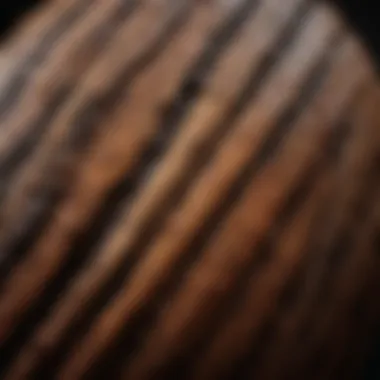
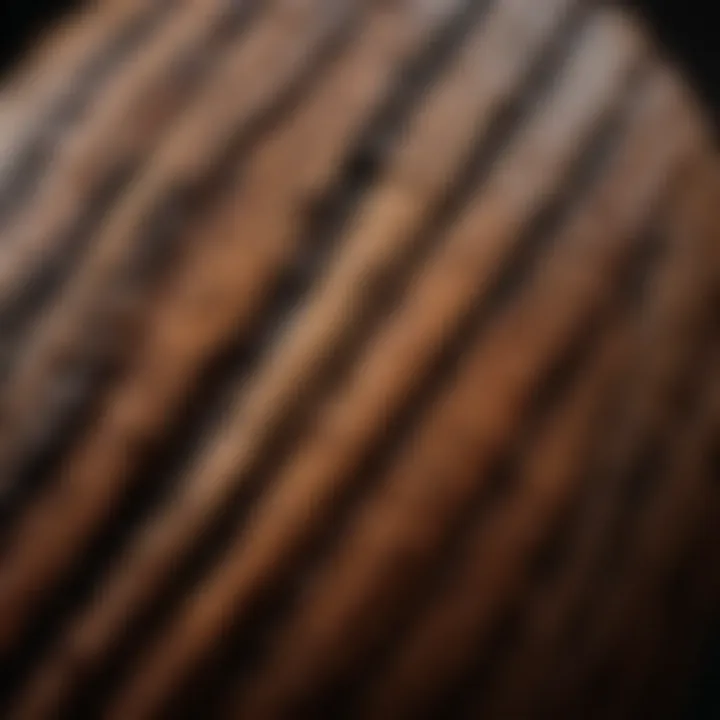
Toys and Playtime Ideas
Investing in quality toys—chewable, jingling, or interactive—provides endless amusement. Try rotating toys to keep things fresh.
Training and Tricks
Training sessions can be enjoyable and intellectually engaging for birds. They might pick up simple tricks quickly, serving not just as entertainment but as a bonding experience.
Outdoor Activities and Interaction
Safe outdoor time can be worth it. Birds can engage with the world directly, provided they're kept secure.
DIY Projects for Mental Stimulation
Creating your toys or foraging stations can enhance their environment while saving some cash! Using safe materials, you can make a variety of intriguing challenges for your birds.
Understanding Java trees and their integration into bird care is not just a niche interest but an enriching journey that promises both well-being and happiness for pet birds and their owners alike.
Prelims to Java Trees
Java trees hold a significant place in both natural ecosystems and avicultural communities. As these trees continue to gain recognition, understanding their characteristics and roles becomes essential for anyone involved in the care of pet birds or those interested in enhancing avian habitats. The unique properties of Java wood, along with its natural resilience, make it a popular choice among bird owners and breeders alike.
In this section, we will delve into two major aspects of Java trees: their definition and their ecological importance. First, defining the Java tree sheds light on its attributes and advantages. Then, exploring the ecological role of these trees reveals why they are crucial not just for birds, but for the health of entire ecosystems.
Defining the Java Tree
Java trees, specifically from the Tectona grandis species, are tall and sturdy hardwood trees primarily found in Southeast Asia. Known commonly as teak trees, they are not only aesthetically pleasing but also incredibly functional. Their dense wood is sought after for various uses, including furniture, flooring, and even bird perches.
- Physical Characteristics: These trees stand out with their expansive canopies and durable trunks, making them naturally appealing for birds to perch on. The wood itself possesses a rich, warm hue ranging from golden to dark brown, often with beautiful grain patterns.
- Growth Conditions: Java trees thrive in tropical climates, preferring well-drained soil and abundant sunlight. Their growth can be slow, but the longevity and durability of the timber pay off over time, resulting in a resource that is both sustainable and robust.
Ecological Role of Java Trees
The importance of Java trees extends far beyond aesthetics. They play a vital role in their ecosystems.
"Java trees contribute significantly to biodiversity, serving as habitats for diverse bird species and other fauna."
- Habitat Provision: These trees provide shelter and nesting areas for various bird species. The sturdiness of Java trees makes them excellent for larger birds, such as parrots, who need stable environments to feel secure.
- Food Source: The leaves and flowers of Java trees also serve as a food source for many species, supporting various layers of the food chain. Additionally, fruit from these trees can attract insects and other animals, thus maintaining a balanced habitat.
- Erosion Control: The extensive root systems of Java trees aid in soil stabilization, preventing erosion and maintaining terrestrial health, which is particularly important in regions prone to heavy rainfall.
By understanding both the definition and ecological attributes of Java trees, pet bird owners can begin to appreciate how these trees contribute to a more enriching environment, reflecting the natural habitats of birds. They not only enhance the aesthetic appeal of living spaces but also appraise a more alive and dynamic ecosystem conducive for birds and other wildlife.
Characteristics of Java Wood
Java wood, harvested from the Java tree, stands out for its distinctive qualities that cater specifically to the needs of pet birds. The physical and natural properties of this wood make it an ideal material for constructing perches, toys, and even habitats. These characteristics play an essential role in promoting avian health and well-being, making them necessary knowledge for bird enthusiasts. Understanding these elements can help bird owners choose the right wood to create adequate and enriching environments for their feathered friends.
Physical Properties
When it comes to physical properties, Java wood is known for its strength and aesthetic appeal. The following aspects highlight its key benefits:
Density and Durability
The density of Java wood contributes significantly to its durability. It has a tight grain structure that not only makes it resistant to wear and tear but also ensures that it can withstand the vigorous activity of birds. This characteristic is extremely valuable, making it a preferred choice among bird owners looking for long-lasting perches.
One of the unique features of Java's durability is how it can withstand the challenging environment of bird cages. Unlike many softer woods that may splinter or degrade over time, Java wood remains robust, ensuring that it provides reliable support for birds while they perch, climb, and engage in their natural behaviors. However, its density can make it heavier compared to other wood types, which may deter some individuals from moving it frequently or repositioning it within their living spaces.
Grain Patterns and Coloration
The grain patterns and coloration of Java wood contribute significantly to its visual appeal. The rich hues and varied grain designs make it not only functional but also aesthetically pleasing. These aspects can add a natural touch to any living space or aviary, complementing the environment for both the birds and their human companions.
Moreover, the unique feature of Java's grain is its ability to blend effortlessly with other decorative elements within a home. This makes Java wood versatile, serving as a conversation starter while providing a comfortable perch for the birds. The variability in coloration does come with a downside, as the appearance may change slightly with exposure to light and time, which some may perceive as a drawback for maintaining an initially pristine look.
Natural Resistance
Next, exploring the natural resistance of Java wood provides insights into its advantages and contributes to the overall topic of avian environments.
Resistance to Insects and Fungi
Java wood naturally possesses a robust resistance to insects and fungi, which is critical for maintaining a healthy living space for birds. This resistance acts like a protective barrier, reducing the likelihood of infestations and fungal growth that can harm both the wood and the birds.
This property makes it an extremely beneficial choice for bird perches and toys, as the materials remain safe for long periods. A unique feature of this resistance is that it minimizes the need for chemical treatments, promoting a healthier habitat for the birds. However, potential downsides may arise if the wood is not properly sourced, as lower-quality pieces could lack these natural antifungal and insect-repellent properties.
Longevity in Avian Environments
The longevity of Java wood in avian environments is another compelling aspect that accentuates its appeal. The inherent properties of Java wood allow it to endure typical wear and tear associated with bird activities. This longevity not only ensures a sustainable choice for pet owners but also provides a sense of reliability in caring for their birds.
What makes it stand out is how it manages to maintain both integrity and aesthetics over time, making it a valuable investment. Higher longevity means less frequent replacements, ultimately saving costs for bird owners. However, some may find that prolonged exposure to moisture can still affect its lifespan, requiring periodic checks to ensure it remains in good condition.
"Choosing Java wood for your birds is not just about aesthetics; it’s about ensuring a safe and lasting environment that promotes their well-being and comfort.."
Benefits of Using Java Trees in Bird Care
Java trees offer more than just a decorative touch to bird habitats; they serve critical roles in promoting the overall well-being of our feathered companions. By mimicking elements of their natural environment, these trees provide essential support for behaviors that are necessary for a bird’s physical and psychological health. Using Java trees, bird owners can encourage natural instincts, create engaging living spaces, and enhance the quality of life for their pets.
Promoting Natural Behaviors
Perching and Climbing
Perching and climbing are fundamental to a bird's daily activities. Birds are instinctively drawn to elevated positions for safety and observation, and Java trees provide sturdy branches that cater to this need. Java wood is dense and stable, giving birds a reliable place to land and explore. Their natural curves mimic the varied branches found in the wild, allowing birds to exercise their limbs and develop strong muscles, ultimately leading to better overall health.
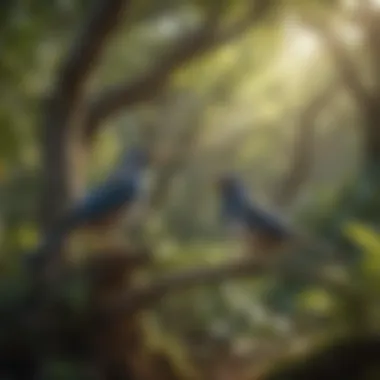

By encouraging perching, these trees reduce stress and promote social interaction among birds. They become something of a social hub, where birds can exhibit their natural hierarchy and gather for relaxation or play. The texture and angle of Java branches stimulate the birds' instincts to nest and roost, offering them experiences they might miss in a less natural setting.
Advantages:*
- Sturdy Construction: Birds of all sizes can safely perch without concern of the branches bending or breaking.
- Varied Heights: Multi-level perching allows birds to choose their preferred elevation, promoting their natural behavior.
Disadvantages:*
- Space Requirements: Larger trees can occupy significant space, and placement becomes critical in a home environment.
Nesting and Foraging
Nesting is another aspect where Java trees excel. These trees can inspire birds to engage in behaviors related to building nests, which is vital for many species. Using natural materials found in their environment can encourage avian creativity. The textured surfaces of Java wood can provide an excellent foundation, allowing them to weave twigs and dried grass comfortably. Foraging, too, is enriched by using these trees, as they can be adorned with edible materials or foraging toys, offering an engaging activity that reflects their wild instincts.
Key Characteristics:*
- Natural Texture: Offers grip for nesting materials, allowing for a more enjoyable experience for birds.
- Customizable Elements: Owners can easily enhance the foraging experience by adding various textures and food placements
Advantages:*
- Enriched Experience: Encourages mental stimulation and meets physical needs inherent in their behaviors.
- Increased Activity: Nurtures active exploration and discovery, reducing feelings of boredom or loneliness, especially in single bird households.
Disadvantages:*
- Maintenance: Nesting materials can require cleaning, and frequent adjustments may be needed to keep the area tidy.
Enhancing Mental Stimulation
Integrating Java trees into a bird's environment goes a long way in boosting mental stimulation. Birds are inherently intelligent creatures. They thrive in settings where they can puzzle through activities, explore new textures, and interact with their surroundings. Java trees offer a canvas for such engagements. The ability to climb, perch, and forage on these trees promotes cognitive function, keeping birds sharp and active.
"A stimulated bird is a happy bird,” highlighting the importance of enriching their living environment as much as feeding them properly.
Ultimately, when considering Java trees for avian care, it's not just about providing a perch; it's about creating a multifaceted ecosystem where birds can live, thrive, and reflect their natural lives. In the end, the benefits outlined here can lead to long-lasting happiness in our cherished pets.
Setting Up Java Trees in Living Spaces
The incorporation of Java trees into living spaces for birds goes beyond mere aesthetics. It's about creating a sanctuary that reflects the birds' natural habitats while ensuring their comfort and well-being. A well-set-up environment can boost the birds' mental health and encourage behaviors that come instinctively to them in the wild. Therefore, this section will navigate the nuances of effectively setting up Java trees thereby enhancing the avian experience in our homes.
Choosing the Right Size
Considerations for Small vs. Large Birds
When choosing a Java tree, it’s vital to take into account the different sizes of the birds who will be using it. For example, smaller birds like budgies might benefit from narrower branches where they can easily grip and perch. In contrast, larger birds, such as macaws, require sturdier branches that can support their weight and also provide enough space to land safely.
Choosing a tree that matches a bird’s size and behavior plays an essential role in their physical comfort and mental engagement. Bigger trees give ample space for exploration and play which is especially crucial for larger species. However, small birds will often feel safer on more compact setups. This tailored approach is a distinctive strategy that can lead to increased happiness among your pets.
Space Availability in Home
Let's talk about the available space within the home, as it's a crucial aspect often underestimated. The area where the Java tree will be placed should not only accommodate the height and width of the tree but also allow the birds to move freely. Clutter can create an anxious environment, something you want to avoid.
The key characteristic here is to find a balance between aesthetic appeal and the practicality of a comfortable shelter. You should determine whether the area receives enough light and whether the placement will allow for easy access, both for you and the birds. A spacious setup enhances interaction and socialization, playing a massive role in their overall well-being. Depending on your living arrangement, you may encounter limitations that could either enhance or restrict what you can set up.
Placement Strategies
Sunlight and Heat Requirements
One major consideration in placing Java trees is ensuring adequate sunlight and heat for the birds. Natural light plays a vital role in the health of avian pets, influencing their moods and stimulating natural behaviors. Java trees should be positioned where they can soak up sunlight but not too much, to the point of overheating.
The unique feature of creating a serene, sunlit environment means that you’ll promote optimal health while allowing the birds to feel connected to their natural surroundings. Overexposure, however, can lead to distress or fatigue in birds, so finding that right sweet spot is essential.
Avoiding Stressful Environments
Ensuring a peaceful environment is just as important as sunlight. Birds can be easily stressed by loud noises, sudden movements, or frequent changes in their surroundings. Choosing a spot that minimizes disturbances creates a more secure atmosphere which is beneficial for their mental stability.
Position the Java tree away from high-traffic areas where people or pets can create chaos. Birds thrive in environments where they can see, but not be overwhelmed by, activity. This thoughtful consideration allows them to engage with their natural instincts while still feeling safe and secure.
Integrating with Other Perches and Toys
Integration of Java trees with other perches and toys will offer a dynamic environment for the birds. Think about adding different levels of perches nearby, or even swings that can entice your feathered friends to explore.
Mixing up the features can stimulate exploration and curiosity which are essential to avian happiness. Toys that encourage interaction, along with the natural wood of Java trees, can foster a vibrant and exciting living space for pet birds.
The harmonious blend of nature and playful elements can significantly elevate their living conditions. Creating multiple areas geared for play and rest can also prevent boredom, promoting healthier behaviors.
In summary, setting up Java trees thoughtfully in a living space involves paying attention to the individual needs of birds, the characteristics of your home, and the environmental factors at play. A well-executed setup not only brightens the aesthetic of a home but also provides an essential refuge for avian companions.
Care and Maintenance of Java Trees
Caring for and maintaining Java trees is crucial for ensuring a safe, healthy, and enriching environment for pet birds. This involves diligent cleaning, monitoring for physical damage, and using the right products to preserve the integrity of the wood while protecting the birds. A well-maintained Java tree not only prolongs its lifespan but also enhances its functionality as a habitat for avian friends. Healthy trees mean happier birds, and happier birds mean a vibrant home.
Cleaning and Sanitation
Cleaning a Java tree may sound like just another chore, but it's an absolute cornerstone of bird care. Birds are naturally curious and tend to explore their surroundings with great enthusiasm, including chewing on the wood. Over time, droppings, uneaten food, and dust can accumulate, leading to unsanitary conditions. Dirty environments aren't just unattractive; they can foster mold and bacteria, which could put your birds at risk.
Preventing Mold and Bacteria Build-Up
Preventing mold and bacteria build-up is essential in maintaining cleanliness. Mold thrives in damp environments, and poorly cleaned Java trees may become a breeding ground for unwanted microorganisms. Various cleaning routines can significantly reduce this risk. Regularly wiping down surfaces and ensuring the wood dries correctly are pivotal steps.
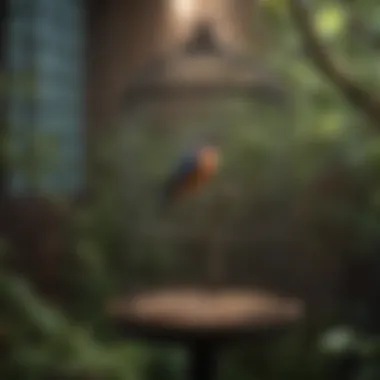
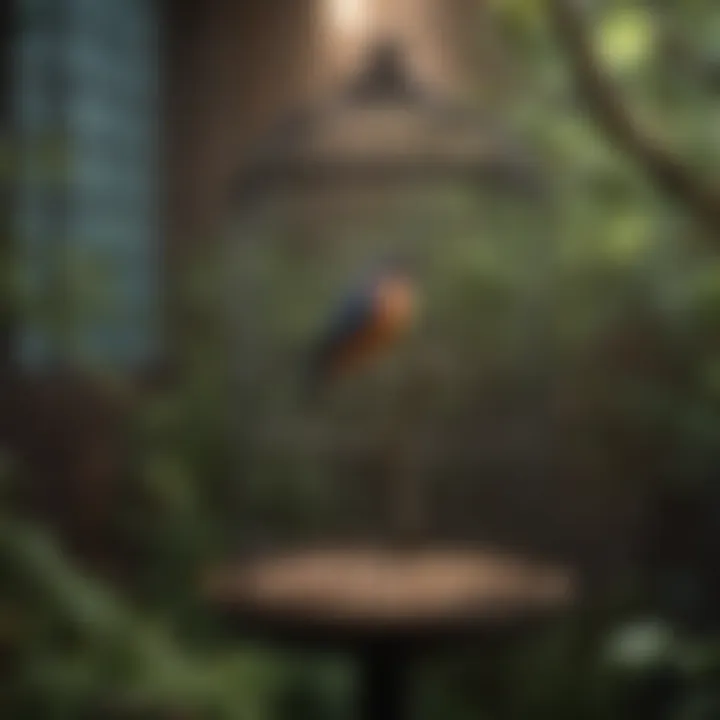
To effectively prevent these issues, consider:
- Regular Inspections: Checking for dampness or any signs of mold can prevent larger problems.
- Proper Ventilation: Ensure the area around the Java tree allows for proper airflow, especially after cleaning.
When you keep an eye on moisture levels and adhere to cleaning routines, you not only protect your trees but also make sure your birds can thrive without health threats.
Safe Cleaning Products
Using safe cleaning products can't be stressed enough. Birds have sensitive respiratory systems, making them more susceptible to harmful chemicals. Instead, opt for natural options that won't irritate their lungs. For instance, using vinegar or baking soda solutions can be effective and are safe for both the birds and the environment.
Advantages of using safe cleaning products include:
- Non-Toxic: They eliminate harmful chemical residues.
- Eco-Friendly: Safe for the environment and reduce pollution.
That said, be cautious and avoid using any products with strong fragrances or harsh chemicals, as they could do harm to both birds and their habitats.
Monitoring for Damage
Regularly monitoring for damage is just as vital as cleaning. Java trees, while durable, can still be affected by the wear and tear of enthusiastic little beaks. Splintering or cracking can pose risks, not only to the aesthetics of the tree but also to the safety of your birds.
Inspecting for Splintering
Inspecting for splintering involves a simple yet thorough examination of the Java tree's surface. Birds, especially those that are often active and playful, may inadvertently cause damage over time. By regularly checking for sharp edges or splintered wood, you're ensuring a safe space for your feathered friends.
Focus on:
- Frequent Surveys: Make it a habit to check the tree weekly.
- Using Your Hands: Feel along the surfaces for any roughness or edges that seem out of place.
The proactive approach will keep your birds safe and avoid potentially damaging accidents.
Replacing Worn Parts
Eventually, even the most carefully maintained Java trees will need parts replaced due to wear. This may include sections of the wood that become too worn or any attached accessories like swings or toys.
Keeping a few spare pieces of wood handy means you don’t have to scramble when a piece wearing out eventually presents itself. It's also a good idea to maintain the structural integrity of the tree for safety's sake. If something looks questionable, it’s better to swap it out promptly rather than risk injury to your birds.
Consider this when replacing worn parts:
- Material Quality: Make sure to use the same type of wood or compatible materials.
- Easy Replacement: If you're regularly inspecting, replacing should be quick and hassle-free.
A little bit of extra attention goes a long way in maintaining a healthy habitat that caters to the needs of your beloved birds.
Java Trees and Bird Species Consideration
When it comes to creating an ideal environment for pet birds, the choice of tree species can’t be underestimated. Java trees present a versatile option that caters well to various bird species, thanks to their robust characteristics and engaging structure. It’s not just about aesthetics; these trees play a functional role in promoting the well-being and natural behaviors of our feathered friends.
Species-Specific Needs
Small Birds: Budgies and Canaries
Budgies and canaries are among the smallest avian companions, often seen flitting about in their cages with their vibrant colors and lively personalities. One of the key aspects of Java trees for these small birds is their branch configuration. This natural structure allows for varied perching opportunities which these playful creatures crave. Small birds like to hop from branch to branch, simulating their wild behavior and enriching their day-to-day experience.
The smooth texture of Java wood, combined with the tree’s stoutness, ensures it holds up well against these playful antics. It’s quite durable, which means it won’t easily splinter, a concern for smaller birds with delicate feet.
- Advantages:
- Facilitates perching and climbing, mimicking their natural habitat.
- Durable wood reduces risk of injury from splintering.
Despite their size, these birds can be quite active, so it’s crucial to consider the height of the Java tree. A carefully selected size can offer these little aviators plenty of room to express their natural instincts without feeling restricted.
Larger Birds: Cockatoos and Macaws
On the other end of the avian spectrum, we find cockatoos and macaws, creatures that demand both space and stimulation. These larger birds are known for their intelligence and social nature. Java trees, with their sturdy branches and thick trunk, can comfortably support a bird of this size.
The key characteristic of larger birds is their natural inclination to chew. Thus, Java wood's hardness becomes an invaluable trait. Unlike softer woods that can be reduced to shavings in days, the resilience of Java wood allows it to withstand the beaks of cockatoos and macaws.
- Advantages:
- Strong structure supports larger weight.
- Natural chewing opportunities without rapid wear.
Still, placement and design become ever more essential with large birds. Cockatoos and macaws thrive in environments that encourage exploration, so integrating various heights and branch thicknesses will keep them engaged and satisfied.
Behavioral Variances
Understanding the behavioral variances across species is essential for designing a suitable habitat. Each bird reacts differently to their environment, and recognizing these needs can greatly enhance their quality of life. For instance, while small birds may prefer cozy spaces with plenty of perches close together, larger birds often enjoy openness and the ability to see their surroundings. By tailoring the Java tree setup according to these distinctions, bird owners can foster an ideal atmosphere that nurtures their pet's physical and emotional health.
Culmination
As we wrap up our exploration of the significance of Java trees in avian care, it becomes clear just how vital these natural structures are for the well-being of our feathered friends. The roles these trees play extend far beyond mere aesthetics; they provide essential components that contribute to both the physical and psychological health of birds kept in captivity. Owners who take the time to integrate Java trees into their pet birds’ environments may notice not just improved behavior, but also increased activity levels and overall contentment.
Recap of Key Points
In this article, we covered several key components regarding Java trees and their impact on birds:
- Ecological Significance: Java trees are more than just decorative elements; they support necessary behaviors such as perching, nesting, and foraging for pet birds, mimicking their natural habitats.
- Unique Properties of Java Wood: The density and natural resistance of Java wood against pests and mold make it an excellent choice for long-lasting perches. This ensures that pet owners are investing in durable items that promote a healthy living space.
- Behavioral Benefits: Utilizing Java trees encourages more natural behaviors, significantly aiding in the mental stimulation of birds. Engaging with these trees can lead to enhanced quality of life.
- Setup and Maintenance: Proper care and integration of Java trees into a bird’s habitat require consideration of size, placement, and regular maintenance, ensuring both functionality and hygiene.
Future Considerations for Avian Environments
Bird care continues evolving, and as our understanding of avian needs deepens, several future considerations emerge:
- The importance of creating a multi-dimensional space using Java trees alongside other environmental elements. This may include varied perch heights and different types of toys to create a stimulating environment.
- A potential for more research into the properties of Java wood, exploring how it can be utilized further in enhancing new habitats for birds. With various wood types available, advancements in the suitable treatment of wood for avian use could improve the longevity and safety of bird environments.
- Sustainable practices in sourcing Java wood should remain a priority. As pet owners, supporting ethically sourced products will sustain not just the birds we admire but also the natural habitats from which these trees come.
By adopting these considerations, we not only enhance the lives of our pets but also contribute to the broader goal of preserving and protecting the environment that supports avian life. The integration of Java trees into our avian living spaces is a step towards fostering a more vibrant and enriching life for pet birds.















